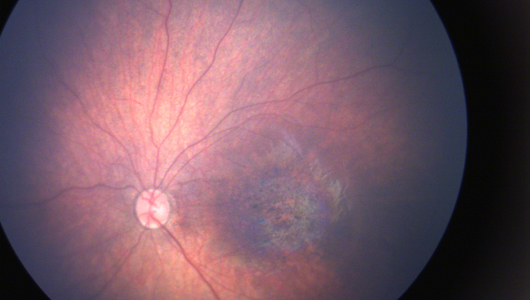Study on zika discloses serious ocular lesions in infants
28/07/2017
Aline Câmara (IFF)
One year and a half after the start of the international health emergency of microcephaly related to congenital zika virus infection, a new study coordinated by specialists from the National Institute of Women, Children and Adolescents Health Fernandes Figueira (IFF/Fiocruz) found that ocular abnormalities can be the only initial finding of infants whose mothers were infected during pregnancy. According to researchers, the finding suggests the need to rethink the evaluation criteria in neonatal screening to include sunken eye exams for all infants with potential maternal exposure to the virus. Published in the renowned American journal The Journal of the American Medical Association (Jama), the article is the result of a partnership of Fiocruz, through IFF and the National Institute of Infectology (INI/Fiocruz), with the University of California and the Federal University of Sso Paulo (Unifesp).

(Picture: Fiocruz)
The work involved the largest series of confirmed cases of zika exposure with data collected systematically. "We were able to make a descriptive study of ocular abnormalities, correlating them with findings of the central nervous system, occurrence of microcephaly, and the moment of maternal infection from a robust cohort involving babies whose mothers had a positive laboratory result for infection during pregnancy", said IFF pediatric ophthalmologist and author Andrea Zin. In addition to Dr. Zin, six other researchers from the Institute participated: Maria Elisabeth Moreira, Zilton Vasconcelos, Marcos Vinicius Pone, Sheila Pone, Mitsue Aibe and Ana Carolina da Costa.
Of the 112 children monitored from birth to six months of age, 46 had no diagnosis of microcephaly. However, ten of them had ocular abnormalities detected by sunken eye exam. The number represents 42% of children with some type of ophthalmic lesion, with problems related to optic nerve and retina the most frequent findings. The study also found that most pregnant women were infected in the first trimester (58%). In 33% of the cases, the infection occurred in the second trimester, and in 8% at the end of gestation, in the third trimester.
Current guidelines recommend eye exams in infants with microcephaly, but do not include all children potentially exposed to the zika virus in the uterus. "We found significant lesions in children who did not have microcephaly. These are serious changes and the earlier the diagnosis is made, the sooner the child can undergo an intervention to enable vision. With these findings, we emphasize the need to rethink the evaluation criteria in order to include the sunken eye exam in the neonatal screening of all infants with potential maternal exposure to the virus," Andrea Zin said.
The findings, illustrated in the Jama article, were recorded through RetCam, a special photographic camera acquired by Fiocruz late last year. The investment was fundamental to enable the study and its publication. "Through this equipment, which photographs the eye fundus at 360º, we were able to document the changes with great detail, allowing the comparison of subsequent exams. Therefore, it was possible not only to refine the diagnostic capacity, but also to make the exchange of information between specialists more accessible", the researcher said.




